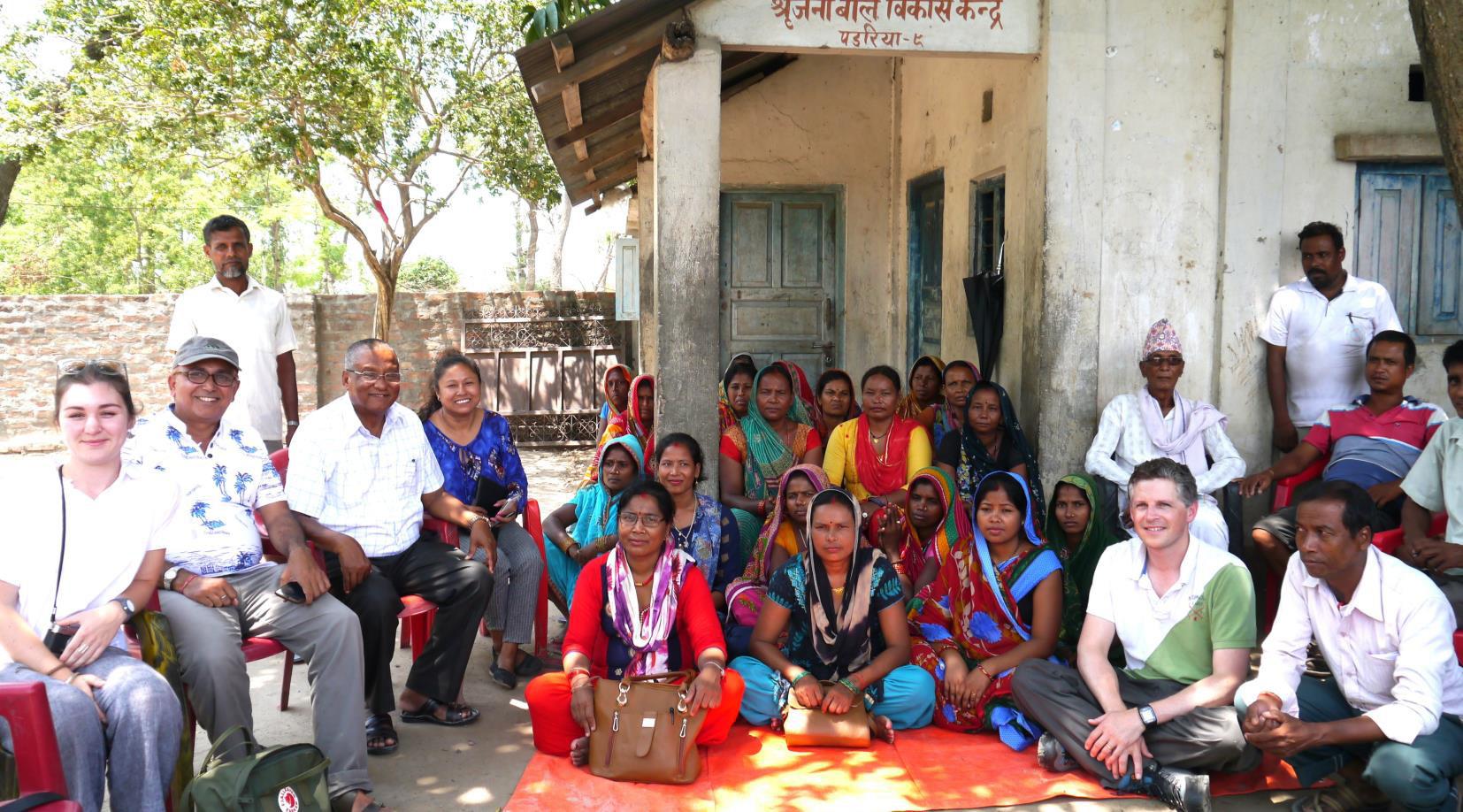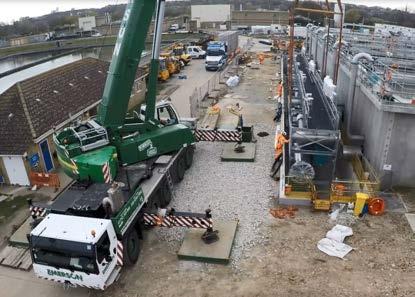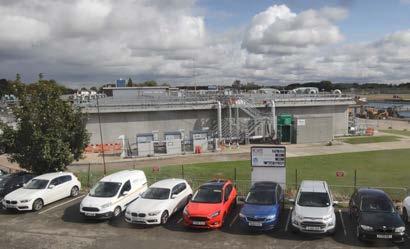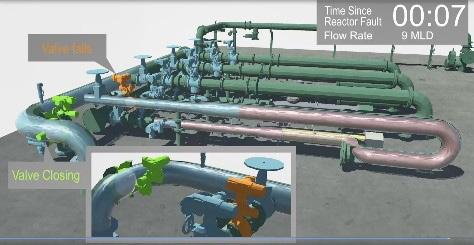




Newsletter | Summer 2020 Building a Be t ter World foundations MWH’s Digital Renderings for the Southeast Water Pollution Control Plant Biosolids Digester Facilities Project in San Francisco THE DIGITAL DELIVERY ISSUE
A Few Words From Blair
Hello Everyone,

















It goes without saying that these are unprecedented times we each find ourselves in, and this extends to MWH as a company in continuing to provide services deemed “essential.” As you all know, our clients do not have the option to shut down a single day. If one of our high-tech industrial or water municipality clients ceased operations, this would result in thousands of potential end-users being denied the basic human need of clean, usable water. I acknowledge this puts an undue stress on the people of MWH, and I want to personally thank everyone for the hard work you do every single day. Additionally, many of our people do not have the opportunity to work-from-home due to much of our work requiring jobsite presence, and for this reason those individuals have our utmost appreciation!!!


Even in these times, I can honestly say I have witnessed employees living out all of our MWH Core Values:




























































































Make a Difference Act with Integrity
Build Customer Partnership Be a Team Be Accountable


Let’s continue to keep these values at the forefront of our minds as the school season arrives. These coming weeks will add another level of stress for individuals with children. Please be open with these colleagues and let us remember our Core Value of Being a Team Our employees with children may need extra help from other team members as they navigate through different school schedules, find daycare, and establish coordination. Finally, I would like to remind everyone that it is most important that we all complete a family plan to deal with these situations and to create a reasonable work-life balance.
Stay safe everyone — see you soon.


 Blair
Blair
 Blair M. Lavoie, PE President & CEO
Blair M. Lavoie, PE President & CEO

In This Issue
contents Using Wastewater to Track COVID-19 2 MWH Wins Additional TRA Project 2 digital delivery | Concrete Examples 3 Central Contra Costa’s Solids Handling Project 4 Bringing Clean Water to Nepal 6 Salton Sea | Protecting Habitat & Providing Water Conservation 8 UK | Coppermills 10 UK | mView 11 UK | Digital Twins 12 Topsham, Maine Project 13 Colorado Employees Help Feed Community 14
Kiersten Lee Vice President Director of Construction Services Steve Fox Vice President Senior Project Manager Adam Ward Vice President Director of Construction Services Dean Breaux Vice President Chief Estimator Matt McCrery Vice President Director of Preconstruction Jeremy McVey Vice President Business Development Jim Bowley Vice President CMS Regional Director Jeff Wall Vice President Senior Project Manager, Slayden
Digital Delivery in Action at the MWH PAR 1244
Denver to MWH’s Newest VPs! congratulations 1
Project in
Using Wastewater to Track COVID-19































Wastewater Sampling Holds Clues to COVID-19 Trends








































UNITED STATES -- Since the emergence of the novel coronavirus this spring, governments have been searching for ways to track coronavirus spread, and analysis of wastewater samples in local treatment plants may provide clues to its prevalence in communities. Recent research has shown that the genetic material, or RNA, of SARS-CoV-2, the virus that causes COVID-19, can be detected in wastewater up to two weeks before diagnosis and up to three days before symptoms begin to show. As RNA from the SARSCoV-2 is shed by carriers of COVID-19, it is funneled into local wastewater systems via human waste. This RNA has shown up with increasing prevalence as cases have risen in the areas the treatment plants service, giving scientists a way to track the virus.


How Wastewater Testing Benefits Communities
This technology itself is not new. Governments have tracked diseases through wastewater before, including monitoring for both polio and opioid use in communities. While such

testing cannot yet tell us how many COVID-19 cases a community might have, it can help us to log trends and indicate whether infection rates are rising or falling. This information is essential, providing a broad picture of how the virus is moving, and may alert states to possible outbreaks even if carriers are asymptomatic. Tracking the trends of SARS-CoV-2 in wastewater can give public health systems the warning they need, allowing them to prepare for an increase in hospital beds and services in advance and stay abreast of outbreaks.




DIGITAL DELIVERY concrete examples
MWH Constructors’ approach to Virtual Design and Construction is focused on optimizing our core work processes and de-risking construction complexity. This not only improves productivity but also enhances safety (our leading core value), competitiveness, and profitability. Projects of note currently deploying digital delivery in the U.S. include the San Francisco BDFP, PAR 1244 in Denver, Saco River and Brunswick in Maine, Corrosion Control in Portland, TRA in Texas, and multiple Slayden projects.
DIGITAL REHEARSAL The continuous linking of 3D design models to CPM schedules is referred to as 4D scheduling. Before construction starts, planners use 4D scheduling so that major construction activities are planned out in a safe, virtual environment. This planning approach identifies conflicts and challenges in the construction sequencing so that the tasks can be optimized in virtual space to avoid problems in the field. The impact on reducing onsite construction time, costs, and avoiding delays can be significant. Additionally, the beneficial effect on safety is immediate with all field personnel understanding in detail the construction activities required and how to best perform them safely. A prime example of this is at the Saco River WTP project where the onsite project team has led a 4D scheduling effort that will lead to major cost savings and reduced time for construction.

MWH Wins Additional TRA Project









































































































































































































DALLAS, TX -- Ground broke on June 15 for a new project within the Trinity River Authority (TRA) site in Dallas, Texas.



































In March, MWH was awarded the bid for the Headworks A Fine Screen Facility project. This $26M hard bid will be constructed at the site of TRA’s Central Regional Wastewater System (CWRS), which serves 1.2 million people in the Dallas/Fort Worth area. The project includes an electrical substation, new flow control valve, demolition of existing structures and will require construction of a 70-foot tall building located on a small footprint within the existing site.
MWH is already working with TRA at the CWRS, having been selected for their Phase III-B Solids Improvements project in 2017. That $196M project, expected to conclude in 2022, will utilize Cambi Thermolysis technology, replacing the current lime stabilization process currently in place. Winning the Headworks A Fine Screen Facility contract will benefit our local teams by allowing MWH to continue to employ laborers at the site.
DIGITAL COORDINATION Unidentified clashes typically lead to costly change orders. Effective clash detection involves finding hard clashes (two components literally intersecting in the design) and soft clashes (the placement of design components could create challenges during construction and/or plant operations). Identifying and resolving these issues using models is intuitive, faster, more accurate, and more collaborative than from drawings. As an example, for the PAR 1244 Project in Denver, over 300 significant clashes for a 20,000 sq ft solids processing building were identified and coordinated directly with all involved trade contractors. Using the model-based process eliminated at least $100K in costs.



























Trends in the industry from owners and operators point to their increasing expectation for builders to deploy digital delivery in construction, and to also deliver a “digital asset” upon project completion at handover. The recently won Portland Bull Run Filtration Project is a key new opportunity for us in this area.
At the end of the day, it is all about communicating. MWH uses our Digital Toolbox to communicate to the delivery team to work smarter and safer. Profitable projects that are completed on time and on budget make for happy clients and builders.
 MWH’s intranet, H2O will be featuring articles and new information about digital delivery on a regular basis. Check it out!
Laser Scanning for Yard Pipe Coordination
Digital Rehearsal | Analyze Schedule Alternatives
MWH’s intranet, H2O will be featuring articles and new information about digital delivery on a regular basis. Check it out!
Laser Scanning for Yard Pipe Coordination
Digital Rehearsal | Analyze Schedule Alternatives
3 2
Digital Coordination | Section of Clash Report
MWH Providing Construction Management and Inspection Services to Central Contra Costa’s
Solids Handling Project
MARTINEZ, CA -- Central Contra Costa Sanitary District (Central San) collects and treats an average total of 35 million gallons per day (mgd) of wastewater for 480,000 residents and 3,000 businesses in central Contra Costa County, an area in the northern portion of the East Bay region of the San Francisco Bay Area.
Central San’s Treatment Plant opened in 1948 and has been upgraded several times in its 60+ year history. Located in the City of Martinez, the plant has a treatment capacity of 54 mgd and 240 mgd of wet weather flow.

The plant provides secondary treatment of domestic, commercial, and industrial wastewater for Danville, Lafayette, Martinez, Moraga, Orinda, Pleasant Hill, San Ramon, Walnut Creek, Concord, Clayton and adjacent unincorporated areas, including Alamo, Blackhawk, Clyde, Pacheco and 22 significant industrial users. The plant produces Title 22 recycled water for onsite use, landscape irrigation, and other recycled water uses within Central San’s service area.
To meet demand and assess usage, Central San completed a Comprehensive Wastewater Master Plan that established near-term, long-term, and future improvements to the treatment plant in 2017. This plan addressed the solids process and several immediate and near-term needs to ensure continued, reliable function of the solids handling facilities.

This project provides for the replacement and improvements of the solids handling components within the next five years. Other components of the project

include the rehabilitation and replacement of the sludge dewatering, sludge handling, sludge blending and ash handling systems, furnace air pollution control equipment, and structural upgrades to the building housing this equipment.
This three-year, $8M project will provide Construction Management and Inspection (CM&I) services including: review of bid documents, specialty inspection, scheduling assistance, communications, change order assistance, training, quality control, document control, construction contract close-out services and providing expert staff including a construction manager and inspectors.
Construction Management and Inspection Services for the Solids Handling Facilities Improvement Project.
Client:
Central Contra Costa Sanitary District (Central San)

Location: Martinez, California
Project Size: 54 million gallons per day (mgd) and 240 mgd of wet weather flow
Project Cost: $82 Million
Key Issues: Schedule adherence and incentives, regulatory compliance, public outreach, digital construction, contractor coordination and capacity concerns.
Services: Construction management and inspection, review of bid documents, providing expert staff including a construction manager and inspectors, specialty inspection, scheduling assistance, communications, change order assistance, training, quality control, document control, and construction contract close-out.
Did You Know?
Central Sans Treatment Plant collects and cleans more than 13 billion gallons of wastewater per year.
The furnace at the plant incinerates approximately 200 tons of sludge per day, reducing that volume to only 14 tons of sterile ash that is used in fertilizers.
The plant produces approximately 600 million gallons of recycled water each year for plant operations, industrial uses, and landscape irrigation.

5 4
Bringing Clean Water to Nepal





NEPAL -- Turning on the tap for a glass of water and using a toilet that flushes are things that are taken for granted in our modern lives. But 844 million people in the world do not have access to clean water in their homes. One in three do not have a toilet. This causes serious public health and safety concerns in these communities, where lack of sanitation and hygiene contributes to disease.
MWH is proud to be part of The Beacon Project, an initiative to improve sanitation and water for the city of Lahan, Nepal. It is a collaboration with WaterAid (an international nonprofit focusing on clean water), Anglian Water in the UK, the Nepalese government and multiple water industry corporations including MWH. This project will expand clean water services in Lahan by enhancing its current water infrastructure and extending piped services to local homes.
Of the 98,000 people living in Lahan, less than half have access to piped water. Waste management systems are inadequate and include only one treatment works facility, five boreholes and 59 kilometers of pipes for the entire city. What makes the Beacon Project unique is that, rather than introducing huge changes that would be difficult for local technicians to implement and run, the organization aims to provide infrastructure enhancements that work within the framework of the existing system. Using a combination of upgrades and training, their five-year goal is to create a water and waste services network that can be managed by a small number of local staff, only eight of which are full-time.
The Beacon Project has already introduced leakage detection technology to the local technicians to reduce the


amount of water being lost in the system. Quality testing, once an annual or bi-annual occurrence, now happens on a regular basis. And at the start of the COVID-19 crisis, the city government introduced public handwashing facilities to minimize transmission of the virus. Their goals for 2020 and
2021 include establishing community toilets and facilities in up to ten local schools and implementing two operational Distric Meter Areas which will supply 24/7 water in two wards.

844 million people in the world do not have access to clean water in their homes.
1 out of 3 do NOT have a toilet
7 6
MWH Selected to Help Protect Habitat and Provide Water Conservation in one of the Driest Regions in the Country
MECCA, CA -- MWH Constructors was selected as the primary construction management consultant for the State of California’s Department of Water Resources’ Salton Sea Species Conservation Habitat (SCH) Design-Build Project at the New River.
The project entails providing Construction Project Management Services (CPMS) including technical advice and consultation in the areas of construction management and contract administration, inspection, project management and other CPMS related engineering and management services.
This 5-year contract, which is part of a 10-year plan for implementing projects around the Salton Sea to protect and enhance the habitat for aquatic and avian wildlife, includes construction management services for water management ponds, berms, islands, mixing/ sediment basin, pump stations, river crossings, a river intake, access corridors, pipelines and habitat and dust suppression projects. Innovative features for the project will include deeper retreat habitat for fish, predation exclusion structures such as netting, integrated sedimentation basins and loafing (behavior not connected with feeding or breeding) islands. The project area encompasses approximately 3,770 acres of exposed lakebed at the mouth of the New River.
Here is a breakdown of Construction Management services to be provided: engineering, field design changes, engineering drawings and submittal review, construction
contract risk management, claims investigations, forensic engineering, schedule analysis, constructability review, contract administration, change order preparation, civil, structural, electrical and mechanical construction inspection and providing expert staff including a mechanical engineer, structural engineer, electrical engineer, civil inspector, and structural inspector.
The Salton Sea is a desert lake that extends from the Coachella Valley into the Imperial Valley in Southern California. It is the largest lake in California at 35 miles long and 15 miles wide, lying below sea level at -227 feet. Though saltier than the ocean, the Salton Sea supports an abundance of fish which are a food source for millions of migratory birds on the Pacific Flyway, a major north-south flyway for migratory birds in America that extends from Alaska to Patagonia.
The Salton Sea was formed in 1905 when Colorado River flood flows breached an irrigation diversion structure and temporarily flowed into the then dry Salton Sink. During the 1950s and 60s, it was a haven for celebrities like Frank Sinatra, but by the 1970s tourism declined and the resort towns around the Salton Sea were left in disrepair. Over the last several decades, water levels have declined and salinity concentrations have increased, leaving the natural state of the Salton Sea in peril.
The retreating shoreline resulting from the arid climate increased water conservation along the Colorado River. Diversion flows to farmlands and naturally occurring gale force winds have left approximately 20,000 acres of dry lakebed exposed. This lakebed mud contains arsenic, selenium, chromium, zinc, lead and pesticides, including DDT from farming and river run-off, which all pose a health risk to those living around the Salton Sea.
Along with efforts to clean up the Salton Sea, this project is aimed at preventing further degradation of air quality
and habitat and will anchor phase one of the state’s Salton Sea Management Program. This program focuses on constructing wetlands and other projects to reduce the health hazards posed by the exposed lakebed and airborne dust to over 50,000 acres of Playa (a dry lake bed at the bottom of a desert basin, also called a sink). For more information on the Salton Sea Habitat Enhancement Project visit the State of California’s Department of Water Resources page at: water.ca.gov/saltonsea.
Salton Sea Species Conservation Habitat Design-Build Project at the New River

Client: State of California Department of Water Resources Location: Mecca, CA (North Shore)

Project Size: 3,770 Acres
Project Cost: $150M
Key Issues: Habitat restoration, environmental mitigation and management, public engagement and visibility, multi-agency coordination and permitting.
Services: Engineering, field design changes and directives, engineering drawings and data submittal review, construction contract risk management, claims investigations, forensic engineering, schedule analysis, constructability review, contract administration, change order preparation, civil, structural, electrical and mechanical construction inspection and staff including a mechanical engineer, structural engineer, electrical engineer, civil inspector and structural inspector.
Did You Know?
The Salton Sea was accidentally created in 1905 when the Colorado River swelled, breached its levees and flooded into the Salton Sink desert valley where water flowed for two years.
The Salton Sea is a key stop on the Pacific flyway for many species of migratory birds.
Because the Sea has no outlet, water is lost only through evaporation, leaving dissolved salts behind and gradually raising salinity.

9 8
When Digital Delivery and DfMA Strategy Come Together Coppermills

WALTHAMSTOW,
UK --
MWH Treatment’s £60M Coppermills Project has been completed with 890 safe days, an 18-month program reduction and £6M in-site preliminary savings. Together with a lower carbon footprint and reduced disruption to the existing operational treatment works, this project was a great success.


The Coppermills project added a new rapid gravity filter block, increasing the existing works capacity to 200 million liters a day (mld), with a scope that included design and build as well as commissioning and startup of the filter. Through early delivery strategy, we identified Design for Manufacture Assembly (DfMA = offsite construction) and digital delivery techniques as ways to reduce costs. 4D simulations were used to rehearse, modify, and optimize detailed critical construction sequences. During closeout activities, our team captured the benefits of the digital delivery strategy and DfMA by measuring onsite activities and comparing them to similar projects delivered in a traditional approach.
What exactly made DfMA and digital delivery Strategy so successful?
• “Holding their nerve” and not panicking or rushing to the site until the design was complete


• Using collaborative rehearsals and 4D simulations with the client and supply chain to separate the program and move activities off site and remove items from the critical path, increasing site productivity

• Reducing
the impact on our client and their customers by focusing on HOW rather than WHAT
Congratulations to the Coppermills Project Team on successfully delivering this flagship project for Thames Water and providing resilience to 750,000 customers in Northeast London.
UNITED KINGDOM -- Have you ever spent time trying to picture what is being described through initial project documentation or used the phrase, “a picture paints a thousand words?” Well, these scenarios were the inspiration for MWH Treatment’s new digital visualisation brand, mView. Tasked with conveying the intent of project solutions to our teams, our customers and their communities. The visualisation team at MWH Treatment (MWHT) worked to create visualisations for several critical project activities. In addition to project rehearsals, the brand covers a number of additional project activities including community engagement, failure mode simulations and process safety, and training.
Community Engagement
As we head into the seventh five-year investment cycle (AMP7) there has been a trend toward Systems Thinking to develop solutions. Systems Thinking allows project teams to consider how different systems integrate and influence each other as a whole during the development process. This includes combining infrastructure work such as water and sewerage networks with our more traditional non-infrastructure work like water and sewerage treatment works. mView Community Engagement uses this System Thinking approach to present the context of a project in an engaging way, enabling our clients to explain its scope to the public in an easily understood format.
Failure Simulation Mode & Process Safety
A significant enhancement on the text heavy Standard Operating Procedures (SOPs) many operators rely on when dealing with incidents, mView
Failure Simulation Mode & Process Safety provides a quick tool for operational teams faced with critical situations. mView addresses potential failures and process safety scenarios as video segments, clearly detailing recommended responses to specific emergencies for client organizations and their staff.

Training
Current COVID-19 restrictions have made it difficult to train our clients’ operational staff. In two of our frameworks, rather than face-to-face training on operation and maintenance of proprietary equipment, we have produced videos for hand-over as well as ongoing operation and maintenance. This allows us to achieve hand-over while our clients’ staff focus on keeping the water flowing.
UK
11 10
UNITED KINGDOM -- Digital twins are a hot trend in the UK Water Sector. Referring to a digital replica of an actual real world process or system, digital twins can be used to run virtual simulations before work is conducted, resulting in increased efficiency and lowering the chance of a costly mistake. The key to the success of digital twins lies in the connectivity between the digital model and the physical asset which allows scenarios to run in the virtual world before utilizing techniques in practice.
The virtual model of the physical asset is critical to digital twin technology. In the past, we produced 2D ‘As-Built’ drawings of projects as part of the hand-over pack which were reviewed, checked, and approved by our clients before being passed on to operational teams. However, ‘As-Built’ drawings are imperfect. They often vary in quality, are time-consuming and expensive to complete, typically utilizing 10% of the engineering budget.


As part of the development of our digital toolbox, MWH Treatment has been developing a software tool that uses AI to automate this process. By comparing a laser scan of the completed works with the 3D model created during design, we can highlight areas of variance between the model and the laser scan with tolerances of millimetres or centimetres. Using this information, the software can suggest changes designed to align the virtual and constructed assets. After this technology was used successfully on the Minworth project, it was deployed at full-scale to Coppermills WTW project with positive results.

Feedback from the site team has confirmed the accuracy of the software and indicated significant efficiencies from the existing ‘As-Built’ drawings. Used on all our projects, this technology could free up to eight engineers to focus on other value-adding tasks.
MWH’s Presence in Maine Continues to Grow

TOPSHAM, ME -- This spring, MWH was awarded the general contract to construct a new water treatment facility for the Brunswick Topsham Water District in Topsham, Maine. This is just an hour north of Saco, where we are currently constructing a 12 mgd drinking water treatment facility. The team is excited to begin work and establish a greater MWH presence in the area. They have already started preconstruction and a formal notice to proceed was issued in early June.

In addition to treatment plant operation, this twoyear project will include a two-story structure with approximately 45,000 square feet and will serve as the home base for Brunswick Topsham Water District. The treatment plant will produce 3.5 mgd when completed and will include six greensand pressure filters, three anion exchange vessels and two manganese contactors. Chemical systems include phosphate, fluoride, potassium
permanganate, chlorine and a brine system. The team is looking forward to some different challenges with architectural details that include brick, precast concrete, stone masonry, insulated metal panels and an interior with an extensive amount of maple millwork.
colorado employees support community food share


BROOMFIELD, CO -- In March, MWH kicked off its Community Food Share Corporate Challenge at its headquarters in Broomfield, Colorado. During this difficult time, millions of people in the United States have lost their jobs and Community Food Share is experiencing a significant strain on their resources. 40,000 people already depended on them before COVID-19 hit, but since the virus, their request for help has doubled and they have distributed 34% more food than normal for this time of year.
At the end of June, when the Corporate Challenge ended, MWH employees had donated $6,436, to Community Food Share with 71% of employees participating. Each dollar donated will provide three meals for low-income residents. Our efforts have supplied 19,308 meals to our community. CEO Blair Lavoie and his wife, Barb, have also matched our contributions up to $1,500.00 which is an additional 4,500 meals. That mean that MWH has helped our neighbors with 23,808 meals that they would not have had access to without this challenge.
Community Food Share distributed over a million pounds of food in March, an all-time record for the organization in its 39-year history. This included 92,000 pounds of fresh produce and dry goods which were earmarked for the Boulder Valley School District for emergency food distribution. Forty different food pantries and meal programs in the Broomfield and Boulder area rely on Community Food Share.
MORE UK
13 12
370 Interlocken Boulevard
Suite 400
Broomfield CO 80021
TREATMENT
The Soapworks
Colgate Lane
Salford
Manchester
M5 3LZ
500 Willamette Avenue
Stayton OR 97383
mwhconstructors.com

Malcolm Road Water Supply Facility Project


NTP: August 6, 2018
Owner: Orange County, Florida
Value: $24M
Estimate Complete: 90%
Forecasted Final Completion: November 2020
Project Overview and Update: MWH is constructing an 8.64 mgd capacity Water Supply Facility located on a 64-acre site at Water Conserve II Rib Site 6, which is an aquifer re-charge site. The site is located on the border of St. John’s River Water Management District and South Florida Water Management District. The project includes two (2) MG pre-stressed ground storage tanks, an 8,000 sq. ft. treatment building, six (6) wells and well houses, four (4) stormwater retention ponds, new site fencing and security gates, and extensive site roadway improvements. The project also includes a large bore under State Road 429, which is a major highway in Central Florida. The bore is 54” diameter casing and is 330 feet long.
Currently: MWH is wrapping up construction and is commencing on the Start-up and Commissioning Phase of the project. We are currently at 700 days without a lost time incident on the project and have logged over 500 days without a recordable. We have been very successful with our self-perform work, completing all scope at or under the budget and estimated man hours. Overall, we are also on track to complete the project under budget.














































































































 Blair M. Lavoie, PE President & CEO
Blair M. Lavoie, PE President & CEO









































